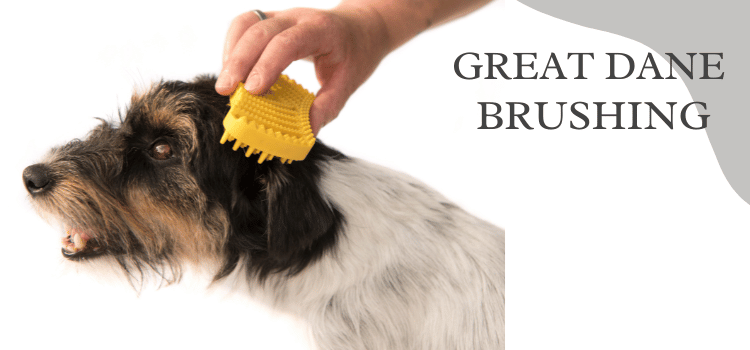If you are considering getting a Great Dane or already own one, you definitely want to know about the Great Dane life span and any potential health issues. Keep reading to find out everything you need to know about the Great Dane’s life span and health issues.
How Long Do Great Danes Live?
Great Danes, often referred to as Deutsche Dogges, are well-known gentle giants despite their size and protectiveness. The average Great Dane lifespan is 8-10 years, but some Danes have been known to live up to 12 years.
Why Are Great Dane Life Spans So Short?
One of the most frequently asked questions about Great Danes is why their life span is so short. Great Danes are one of the largest breeds of dogs and they are also one of the shortest-lived breeds. The average life span for a Great Dane is between 6 and 8 years old, which is much shorter than the average life span for other dog breeds. There are several possible explanations for why the Great Danes had such a short life span.
One possibility is that their large size puts a strain on their organs and bones, which can lead to health problems later in life. Great Danes are also prone to certain genetic health conditions, such as hip dysplasia, that can shorten their life span. Another explanation is that many Great Danes are bred for show and not for health, which means that they may not be as healthy as other dogs who are bred for working or companion purposes.

Whatever the reason for their short life span, it’s important to take good care of your Great Dane while they’re with you. Make sure to feed them a nutritious diet, get them regular exercise, and take them to the vet regularly for check-ups and vaccinations. With proper care, you can help your great dane to live longer.
Great Dane Health problems
As one of the world’s largest breeds, Great Danes are unfortunately also susceptible to a number of health problems. Some of these problems are due to their size, while others are specific to the breed. Great Dane owners need to be aware of these health concerns so they can take steps to prevent them or catch them early if they do occur to enhance the great dane life span.
Bloat
One of the health issues that can affect Great Danes is bloat. Bloat is a condition where the stomach fills with gas and twists, trapping the gas inside. This can be a very serious condition and can even be fatal if not treated quickly. Symptoms of bloat include restlessness, pacing, drooling, and trying to vomit but being unable to. If you think your dog may be bloated, it is important to get them to a vet immediately.
There are several things that can cause bloat, such as eating too fast, drinking too much water before or after exercise, eating from a raised bowl, and anxiety. There are also some health conditions that can make a dog more prone to bloat, such as gastric dilation volvulus (GDV), which is a condition where the stomach twists around itself.
If your dog has GDV, surgery is usually necessary to correct it. You can help prevent bloat by feeding your dog smaller meals more often instead of one large meal a day. You should also avoid giving them food or water right before or after exercise. And if you have a dog with GDV, there are special bowls available that can help prevent it from happening again.
Cardiomyopathy
Many Great Danes suffer from a condition called cardiomyopathy, which contributes in a lower great Dane life span, which is a degeneration of the heart muscle. This can lead to heart failure and death. There is no cure for cardiomyopathy, but treatment can help prolong your dog’s life.
Joint & Bone Disease
One of the most important things you can do to ensure a long and healthy life for your Great Dane is to keep their joints healthy. Unfortunately, Great Danes are prone to joint problems, particularly in their hips and elbows.
There are a few things you can do to help keep your Dane’s joints healthy. First, make sure they get plenty of exercise. This will help keep their muscles strong and support their joints. Second, feed them a healthy diet. A diet rich in omega-3 fatty acids has been shown to be beneficial for joint health. Third, give them joint supplements. supplements can help reduce inflammation and pain in the joints and slow the progression of joint disease.
If your Dane does develop joint problems, there are a number of treatments available. These include weight management, exercise modification, physiotherapy, anti-inflammatory medication, and surgery. Your veterinarian will be able to advise you on the best course of treatment for your Dane’s particular situation. If you track the problems and cure them on time, So, you will surely can increase Great Dane Life span.
Thyroid Problems
The thyroid is a gland that produces hormones that regulate the body’s metabolism. Problems with the thyroid can lead to a number of health issues, including weight gain or loss, fatigue, hair loss, and changes in mood.
Great Danes are particularly susceptible to thyroid problems, and it is important to be aware of the signs and symptoms so that you can get your dog treatment as soon as possible. If you think your dog may have a thyroid problem, take him to the vet for a check-up.
How To Help A Great Dane Live Longer?
As one of the biggest dog breeds, Great Danes have a reputation for being gentle giants. But like all dogs, they’re not immune to health problems.
The average lifespan of a Great Dane is between 6 and 8 years, but with the right care, they can live even longer. Here are some tips on how to help your Great Dane live a long and healthy life:
1. Get them checked out by the vet regularly. Great Danes are prone to health problems like hip dysplasia and bloat, so it’s important to take them for check-ups and screenings at the vet’s office.
2. Keep them at a healthy weight. Obesity can shorten a dog’s lifespan, so make sure your Dane is getting enough exercise and eating a healthy diet.
3. Keep up with their vaccinations. Vaccinations help protect against diseases that could be deadly for your Dane, so make sure they’re up to date on all their shots.
4. Train them properly. Proper socialization and obedience training can help your Dane stay out of trouble and stay safe in any situation.
5. Give them plenty of love and attention.
Responsible Breeding
There are a number of health issues that can affect Great Danes, which is why responsible breeding is so important. By working with a reputable breeder, you can ensure that your dog will be as healthy as possible.

Hip and elbow dysplasia are both hereditary conditions that can cause joint pain and mobility issues. Heart disease is another concern, and it can be fatal if not caught early. Bloat is a potentially life-threatening condition that affects the stomach and can cause it to twist.
While there is no guarantee that your dog will never experience any health problems, you can help to reduce the risk by choosing a healthy breed from a responsible breeder. By working with a reputable breeder, you can get all the information you need to make an informed decision about which dog is right for you.
Balanced and Healthy diet
A proper, balanced diet is essential for a Great Dane’s health and longevity. While they are growing, puppies need a diet that is rich in proteins and calories to support their rapid growth. Adult Great Danes need a diet that is lower in calories and fat to help prevent obesity. Dane owners should consult with their veterinarian about what type of food and how much to feed their dog throughout its life.
Great Danes are also susceptible to bloat, which is a life-threatening condition that can occur when the stomach twists or fills with gas. To help prevent bloat, it is important to feed your Dane several small meals per day instead of one large meal. You should also avoid exercising your dog immediately after eating or drinking.
Preventative Care
As a pet owner, one of the best things you can do for your Great Dane is to understand the potential health problems they may face and take steps to prevent them. While Great Danes are generally healthy dogs, there are some conditions to be aware of.
One way to help your Dane stay healthy is to practice preventive care. This means regular vet check-ups, vaccinations, and tick/flea/heartworm prevention. It also means feeding your dog a high-quality diet and providing them with plenty of exercise.
Another important part of preventive care is knowing the signs of common health problems so you can catch them early and get treatment. Some conditions to watch for include hip dysplasia, bloat, and cancer.
By taking good care of your dog and being aware of potential health problems, you can help your Great Dane live a long and happy life.
Regular Physical Activity
When it comes to maintaining a healthy lifestyle, regular physical activity is key. And this is especially true for Great Danes. Due to their large size, Great Danes are prone to obesity and other health problems if they don’t get enough exercise.
That’s why it’s important to make sure your Great Dane gets plenty of exercise every day. A good rule of thumb is to provide at least 30 minutes of exercise per day, although more is always better. This can be in the form of walks, runs, or even playing fetch in the backyard.
Not only will regular exercise help keep your Great Dane healthy, but it will also help them live a longer life. So get out there and enjoy some quality time with your furry friend!
FAQ
How Old Is The Oldest Living Great Dane Reported?
The oldest living Great Dane reported is 7 years old by oldset.org. The healthiest Great Danes live an average of 11 to 15 years, with some living even longer. Great Danes are susceptible to a number of health problems, including hip and elbow dysplasia, cardiac issues, bloat, and cancer. While there is no guarantee that your Great Dane will live to be a ripe old age, you can help increase their chances by providing them with proper nutrition, exercise, and veterinary care.
How Do You Know If Your Great Dane Is Dying?
No one wants to think about their dog dying, but it’s important to be prepared for the worst. Here are some signs that your Great Dane may be nearing the end of their life:
1. They’re sleeping more than usual.
2. They’ve lost interest in food and water.
3. They’re no longer able to stand or walk.
4. They’re having trouble breathing.
5. Their heartbeat is irregular.
If you notice any of these signs, it’s important to take your dog to the vet right away. While there’s no guarantee that they can be saved, early detection and treatment may improve their chances.
Do Female Great Danes Live Longer Than Males?
There’s a common misconception that female Great Danes live longer than males. However, this isn’t necessarily true. In fact, the average life expectancy for both genders is about the same: around 8 years.
Of course, there are always exceptions to the rule. Some male Great Danes have been known to live 10-12 years, while some females only make it to 6 or 7. But on average, you can expect your Great Dane to have a lifespan of 8 years.
The Four Life Stages of a Great Dane
A Great Dane’s life can be divided into four distinct stages: puppyhood, adolescence, adulthood, and seniorhood. Each stage comes with its own unique set of challenges and joys. Here’s a quick overview of what you can expect during each stage of your Great Dane life span.
Puppyhood: Puppies are full of energy and excitement. They’re also very curious and tend to get into everything. This is the time when you’ll need to do the most training to help your pup learn basic obedience commands and good manners.
Adolescence: Adolescence is when your Great Dane will start to fill out and develop his or her adult appearance. This is also the time when many problem behaviors can start to surface. Be patient and consistent with training during this stage, and you’ll help your Dane develop into a well-mannered adult dog.
Adulthood: Adult Great Danes are typically calm and relaxed. They enjoy spending time with their families and love nothing more than a good cuddle on the couch.
Seniorhood: As your Dane enters his or her golden years, you may notice some changes in behavior or health. Your vet can help you manage any age-related issues and make sure your
How to Tell Your Great Dane’s Age
As a Great Dane owner, it’s important to know your dog’s age. This will help you determine the best care for your pet, as well as anticipate any health issues that may arise. Here are some tips on how to tell your Great Dane’s age.
One way to estimate your dog’s age is by looking at its teeth. Puppies have 28 baby teeth, which they start to lose around 4-6 months of age. By one year old, most Great Danes will have all 42 of their permanent adult teeth. So, if you can see that your dog still has some baby teeth, they are likely under a year old. If all of their adult teeth are in, they are probably over a year old.
Another way to tell your dog’s age is by looking at its body size and weight. Great Danes grow rapidly during their first year of life, so a puppy will be much smaller than an adult dog. You can use this growth chart from the Great Dane Club of America to estimate your dog’s age based on its weight and height.
You may also like to read















